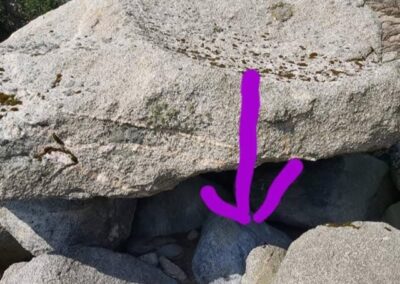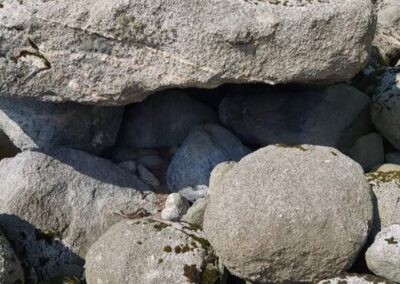Klokka hennes Guri
Type: Ringing stone
Local name: Klokkesteinen, Klokka hennes Guri
Locality
County: Trøndelag
Municipality: Frøya
Location: Kunna, Froan (Froøyene, Froværet)
Kunna is one of the islands in the Froan Landscape Protection Area in the Frohavet. The island was previously inhabited, now only a few buildings remain. The stone is located in a block field just above the flood mark on the island’s southers side.
Description
The stone of approx. 0.5 m3 lies beside other rounded stones under a large stone slab. It is oval and has a smooth surface. The sound is bright and metallic.
Cultural history and tradition
According to tradition, this must have been the bell of Guri Kunna, the mythical and legendary figure about whom there are many stories from the coast of Trøndelag. Today, not many people know about the location of the stone, apart from descendants of the residents of Kunna. One of them, Torkel Sand, says that they used to strike the rock, and throw pebbles at it, when they visited the island. He recalls that it had a better sound earlier than now.
In the play Sangen fra Utvær by Idar Lind (Sør-Trøndelag Teaterverksted and Stiftelsen Frohavet 1995) the legends about Guri Kunna was used, including the story about the stone, which is mentioned in the description of the play: ‘At Kunna there is a large stone that emits such a beautiful sound when you hit it. This is Guri’s bell’. They also write about other stones used by Guri: ‘Down by the beach you see her “åbol”, a rock to which she moors her yachts. There are two caves in the rock, Guristua and Gurisjåen. Surrounding Kunna are seven islets with names ending on ‹-calf›—these are the calves belonging to Guri.’
Guri’s (or Guru’s) bell, which is still found on Kunna, is only a small part of a rich material of legends and folk beliefs that has given life to the landscape on this part of the coast. In the newspaper Fosna-Folket from 2006, there is another version of the bell legend, which may not refer to this particular stone: ‘There are several traces reminding of Guri Kunna both on the islands and in Fosen. A crack in the rock on a small island near Kunna is called ‹Guri’ bell›. When the waves hits the rock, special bell sounds are heard.’
The report Bissegh – Samiske hellige fjell og offerplasser, about Sami cultural monuments (2021) states that Guriklokka may be ‘a sonorous stone that lies in one of the transverse cracks situated north of the highest point on the island’ (p. 66). In the section ‘Klangstein en nykommer i sagnet om Guri Kunna’ [Ringing stone a newcomer in the legend of Guri Kunna] we can read (p. 66): ‘In the legend of Guri Kunna she arrived to Kunna surfing on a rock. Ringing stone, which gives sound, is recorded later in the legends. This opens up the possibility that “bell stone” is the stone that is wedged in the middle and the largest crack of the rock’. This crack is located roughly in the middle of the island.
In Frøyaboka 1 from 1955, there is a piece about Guru Kunna where her bell stone is mentioned (p. 200): ‘The Guruklokka is the name of a large stone on the south side of Kunna, which jingles when you strike it’. This must be the same as the one marked and documented here.
Sources: «Sagn om Guru Kunna, fortalt av poståpner H. Grønskag», in Årsskrift Fosen historielag 1947, p. 98–107; Frøyaboka 1 (Trondheim 1955); «Lokale godsaker», Fosna-Folket 24. October 2006 (s. 20); «Småkalldronninga Guri Kunna», Fosna-Folket 1 September 2017 (p. 28–29); http://lind.no/produksjon/sangen_fra_utvar_program.html; Erik Norberg, Tom Kappfjell og Ingegerd Holand: Bissegh – Samiske hellige fjell og offerplasser. Saemien Sijte, 2021 (page 65–71: «Kunna i Frohavet»).
Many thanks to Torkel Sand for information and documentation.



